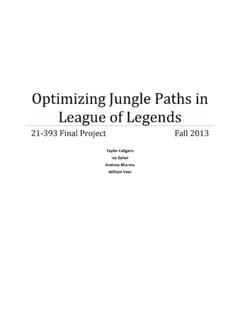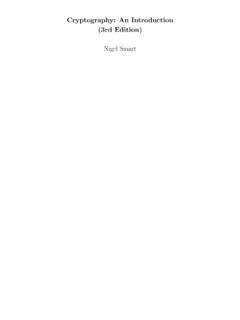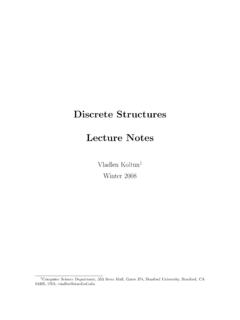Transcription of Modular Arithmetic Practice - CMU
1 Modular Arithmetic PracticeJoseph ZollerSeptember 13, 2015 Practice Problem Solutions1. Given that 5x 6 (mod 8), findx.[Solution: 6]2. Find the last digit of 7100[Solution: 1]7100 (72)50 4950 ( 1)50 1 mod (1992 AHSME 17) The two-digit integers form 19 to 92 are written consecutively to form thelarge integerN= 192021 that 3kis the highest power of 3 that is a factor ofN. What isk?[Solution:k= 1]We know thatN S(N) mod (N) = 1+9+9+0+9+1+9+2+10(2+..+8)+7(0+..9) =40 + 10(35) + 7(45) = 40 + 350 + 315 = 705. ThenN S(N) S(S(N)) S(705) 12 3mod 9. Thus, it is only divisible by 3 and not 9, andk= (2000 AMC 12 18) In yearN, the 300th day of the year is a Tuesday. In yearN+ 1, the 200thday is also a Tuesday. On what day of the week did the 100th day of the yearN 1 occur?[Solution: Thursday]There are either 65 + 200 = 265 or 66 + 200 = 266 days between the first two dates dependingupon whether or not yearNis a leap year. Since 7 divides into 266, then it is possible forboth dates to Tuesday; hence yearN+ 1 is a leap year andN 1 is not a leap year.
2 Thereare 265 + 300 = 565 days between the date in yearsN,N 1, which leaves a remainder of5 upon division by 7. Since we are subtracting days, we count 5 days before Tuesday, whichgives us (2000 AMC 12 9) Mrs. Walter gave an exam in a mathematics class of five students. Sheentered the scores in random order into a spreadsheet, which recalculated the class averageafter each score was entered. Mrs. Walter noticed that after each score was entered, theaverage was always an integer. The scores (listed in ascending order) were 71,76,80,82,and was the last score Mrs. Walter entered.[Solution: 80]The sum of the first three numbers is divisible by 3. The sum of the first four numbers isdivisible by 4. If we write out all 5 numbers in mod 3, we get 2,1,2,1,1,respectively. Clearly1the only way to get a number divisible by 3 by adding three of these is 1 + 1 + 1, so thosescores must be entered first.
3 Now we have an odd sum, so we must add 71 in order for thesum to be divisible by 4. That leaves 80 for the last score Find the number of integersn, 1 n 25 such thatn2+ 3n+ 2 is divisible by 6.[Solution: 13](n+ 1)(n+ 2) 0 2 3 5 6 6 1 mod 6. Therefore (n+ 1) 2,5,6 mod 6, andn 1,4,5 mod 6. There are 5 + 4 + 4 = 13 of these numbers between 1 and Ifn! denotes the product of the integers 1 throughn, what is the remainder when(1! + 2! + 3! + 4! + 5! + 6! +..) is divided by 9?[Solution: 0]First of all, we know thatk! 0 (mod 9) for allk 6. Thus, we only need to find(1! + 2! + 3! + 4! + 5!) (mod 9).1! 1 (mod 9)2! 2 (mod 9)3! 6 (mod 9)4! 24 6 (mod 9)5! 5 6 30 3 (mod 9)Thus,(1! + 2! + 3! + 4! + 5!) 1 + 2 + 6 + 6 + 3 18 0 (mod 9)so the remainder is Prove that 2n+ 6 9nis always divisible by 7 for any positive integern.[Proof:]2 9 (mod 7) = 2n 9n(mod 7) = 2n+ 6 9n 7 9n 0 9n 0 (mod 7).10. (2014 AIME I 8) The positive integersNandN2both end in the same sequence of four digitsabcdwhen written in base 10, where digitais nonzero.
4 Find the three-digit numberabc.[Solution: 937(d= 6)]We have thatN2 N=N(N 1) 0 mod ,N(N 1) must be divisible by both 54and 24. Note, however, that if eitherNorN 1 has both a 5 and a 2 in its factorization, the other must end in either 1 and 9, whichis impossible for a number that is divisible by either 2 or 5. Thus, one of them is divisible by24= 16, and the other is divisible by 54= 625. Noting that 625 1 mod 16, we see that 625would work forN, except the thousands digit is 0. The other possibility is thatNis a multipleof 16 andN 1 is a multiple of 625. In order for this to happen,N 1 must be congruent to 1 mod 16. Since 625 1 mod 16, we know that 15 625 = 9375 15 1 mod 16. Thus,N 1 = 9375, soN= 9376, and our answer is Which digits must we substitute foraandbin 30a0b03 so that the resulting integer is divisibleby 13?[Solution:a= 2, b= 3 ora= 5, b= 2 ora= 8, b= 1]30a0b03 = 3,000,003+a 10,000+b 100 400,003+a 900+b 9 10,003+a ( 10)+b 9 903+a 3+b 9 ( 7)+a 3+b 9 3a+9b 7 0 mod 13.
5 Therefore, 3a+9b 7 20 33mod 13. After dividing by 3 because (3,13) = 1, we geta+ 3b 11 mod 13. Thus we havea= 2, b= 3 ora= 5, b= 2 ora= 8, b= When 30! is computed, it ends in 7 zeros. Find the digit that immediately precedes thesezeros.[Solution: 8]30!/107= 226 314 57 74 112 132 171 191 231 291/107= 219 314 74 112 132 171 191 231 , 30! = 219 314 74 112 132 171 191 231 291 8 9 1 1 9 7 9 3 9 ( 2) ( 1) ( 1) ( 3) ( 1) 3 ( 1) 18 8 mod For how many positive integral values ofx 100 is 3x x2divisible by 5?[Solution: 20]Note that 34 81 1 mod 5. Let x be defined asx smod 20, wheres 20. Thenx smod 4 andx smod 5. These imply that 3x 3smod 20 andx2 s2mod 20, so3x x2 3s s2 0 mod trying values, you will find thats= 2,4,16,or 18 are the only values possible. Thus,that are 4 5 = 20 possible values ofx (2004 AIME 2 10) LetSbe the set of integers between 1 and 240that contain two 1 s whenwritten in base 2.
6 What is the probability that a random integer fromSis divisible by 9?[Solution:133780]Note that since 26= 64 1 (mod 9), the powers of 2 form a cyclic of length 6 in (mod 9).Moreover, for any non-negative integern,26n 1 (mod 9), 26n+1 2 (mod 9), 26n+2 4 (mod 9)26n+3 8 1 (mod 9), 26n+4 16 2 (mod 9), 26n+5 32 4 (mod 9)The solutions that work are in the form 2a+ 2bbecause they must have exactly two 1 s intheir binary representation. Pairs ofaandbhave to be such that 2aand 2badd up to 0 (mod9). Thus, (a, b) must be in one of the following forms:(6c,6d+ 3), (6c+ 1,6d+ 4), or (6c+ 2,6d+ 5)Since the solutions are between 1 and 240, there are 7 7 = 49 choices for the first pair,7 6 = 42 choices for the second pair, and 7 6 = 42 choices for the third pair. Thus, there are49 + 42 + 42 = 133 possible solutions in total. Since there are(402)= 780 numbers that haveexactly two 1 s in their binary representation to choose from, the probability that one of themis divisible by 9 Prove that ifa b(modn), then for all positives integersethat divide bothaandb,ae be(modngcd(n, e))[Proof:]Leta=ceandb=defor somec, d Z.
7 Then,a b(modn) = (a b) =mn= (ce de) =mn= (c d)(e) + ( m)(n) = 0= (c d)(egcd(n, e)) + ( m)(ngcd(n, e)) = 03 Sinceegcd(n, e)andngcd(n, e)are relatively prime, their coefficients must me multiples of theother one, so(c d) is a multiple ofngcd(n, e)= (c d) 0 (modngcd(n, e))= c d(modngcd(n, e))= ae be(modngcd(n, e)) 4

















